eISSN: 2469-2794


Review Article Volume 10 Issue 2
Nottingham Trent University United Kingdom
Correspondence: Andrew O’Hagan, Nottingham Trent University School of Science & Technology, Erasmus Darwin, Room 230, Clifton Lane, Nottingham, NG11 8NS, UK
Received: August 25, 2022 | Published: September 19, 2022
Citation: O’Hagan A, Paraskevi C. Cocaine trafficking between South America and Greece and methods of concealment. Forensic Res Criminol Int J. 2022;10(2):37-43. DOI: 10.15406/frcij.2022.10.00355
This research investigates the cocaine business between South America and Greece, and its trading methods. Cocaine trafficking is a complex political, social, cultural, and moral challenge that transcends national borders in size and importance. This problem as a phenomenon is global and multidimensional, as it involves, from the point of cultivation to the point of consumption, various people, social strata, huge economic interests, countries and even governments. The engagement of specialists from the maritime sector and individuals from the "higher social strata" who actively participate in the shipment and trafficking of cocaine to West Europe and Greece is highlighted. The cocaine industry in Greece is 'structured' by a network of interaction and collaboration involving governmental, commercial, and civil society players, according to information from a range of resources. The largest quantities of cocaine are produced in South American, and in particular in Colombia, Peru, and Bolivia, from where a large percentage of production is destined for European markets. The smuggling business into Europe takes place in large quantities, mainly by sea from coastal areas / ports of South American countries and the Caribbean Islands. Containers are the main transportation method, with quantities being hidden either within the legal cargo or in specially designed crypts. Sailing boats are also a time-honored method of smuggling drugs. The main points of entry of cocaine transported by sea from Latin America to Southern Europe, either directly or through West Africa, via the Mediterranean, is Spain, as well as France, Italy, Portugal, and Greece. Respectively, the cocaine entry points by sea in Northern Europe are mainly the Netherlands, Belgium, and Germany. Then the quantities are shipped to the rest of the European countries. For smaller quantities of cocaine, trafficking to Europe occurs by air from Brazil and other South American countries. Globally, Europe is a major drug market, maintained mainly by drugs smuggled from other parts of the world. Latin America is an important source of drugs entering Europe, which acts as a transit point for cocaine destined for other continents. Additional research is recommended regarding the financial, social, and political interests of the individuals involved in this industry in order to truly evaluate the dynamics of this unlawful trade.
Keywords: drug trafficking, cocaine, globally, Greece, controlled drugs law enforcement
UNODC, United Nations Office on Drugs and Crime; INCB, International Narcotics Control Board
Drug trafficking generates various difficulties for the countries in which it is allowed to become prevalent. It could be considered to be an incomparable destabilizing issue when governance immorality is established along with a number of legal complications. An essential factor in this prevalent phenomenon is also the underdeveloped provincial economies associated with the drug movement rates.
Illegal drug trading prevents both economic and social development, while markedly influencing the highly vulnerable and marginalized cultures. Moreover, it creates an essential coercion for some countries regarding their security and stability. Cocaine is the most trafficked drug following cannabis. This is evidenced by the confiscated amount of cocaine in Europe in 2018 which was the largest that had ever been recorded, rising to 181 tons (138 tons in 2017).1 A number of cases reveals that legal industrialists explore alternative solutions by participating in the cocaine trading when their legitimate businesses are failing.
In recent years, studies relating to drugs conducted in Greece focus mainly on therapeutic approaches and their effectiveness in various methods. Relevant research is related to the medical and socio-psychological dimensions of the usage in regards with the characteristics of the population that is using, the pharmacology, as well as the various policies for a well-organized action plan.2,3 Therefore, the question of understanding this phenomenon is not only the study of the ‘demand’ factor, but also the qualitative and quantitative study of drug trafficking as well as the drug market.
Whilst, in the Greek literature there are several studies concerning the expansion of the use and the users themselves, minimal research emphasis has been placed upon the relationship between the trafficker-user and the market and more generally the drug trafficking of illegal and legal products.4 It is commonly accepted that drugs are products which are purchased and sold in illegal markets where other illegitimate activities occur.5 Worldwide, numerous studies have been conducted investigating the drug supply and trading into the market.6 Frequently, they concentrate on the social organization of the criminal networks involved in the trade, as well as on the economic structure of the market and the effectiveness of law enforcement combating human trafficking.7
An examination of the relationship between trafficking and organized crime reveals that most of this information is based on the experience of law enforcement agencies, which seek to trace, identify, and apprehend traffickers. The analysis of smuggling remains relatively incomplete, provided that often reports are made only for official data originated from the authorities, regarding money laundering and the flow of these substances around the globe.8
This Study will provide adequate knowledge of the cocaine trafficking between South America and Europe and the Concealment and Transportation in Greece. It focuses on the magnitude as well as on the characteristics of this trade among those parts of the world. Furthermore, it instates remarkable prominence on the ‘Greek legitimate associations’, namely on the ‘elite’ of the Greek natives who have been deeply implicated in this particular industry both in Greece and further on. Taking into consideration the complexity of cocaine trafficking, the study contains a multiplicity of aspects converging on and reflecting the financial and socio-cultural variables. If it is presumed that the cocaine marketplace resides in the frame of knowledge broadly characterized as ‘organized crime’ this research can contribute to the theoretical awareness of ‘organized crime’ in Greece.
Cocaine is predominantly cultivated in Colombia, Peru, and Bolivia. Therefore, small vicinity to supply countries as well as a sizeable domestic marketplace established a catalytic part in the cocaine trade development in the Western hemisphere. Primarily unsusceptible by this phenomenon was Europe where mainly privileged individuals consumed cocaine. Nevertheless, as stated by the UNODC (United Nations Office on Drugs and Crime), utilization of cocaine in Europe has been continuously escalating, retail and wholesale values are plummeting, while at the same time the purity levels are meliorating.9 The development of the European marketplace appears to reveal particularly the shifting aspects within the American market. The deteriorating American market, that was influenced by vital law enforcement endeavors as well as immersion associated with the nature of the substance addressed, is accepted to have provided the foundation of trading routes to Europe. Cocaine smugglers have continuously been eager–even though not constantly effective – in distributing their merchandise over the Atlantic exploring trustworthy associations and developing markets.10
This research focuses on the cocaine trade in Greece because the Greek situation offers a sequence of ‘competitive benefits’ in the growth of the cocaine industry both within and outside of the borders. Initially, even though the Greek market is relatively undersized, it consists of one with an extended history while being quite vivid. The research has divulged that cocaine trafficking existed in Greece since around 1910s and 1920s with characteristics comparable to the ones in recent years.11 Back at those years interpersonal systems of experts, lawful businessmen, law specialists, visitors, and voyagers, along with the ‘elite society’, frequently traded in little amounts of the product. European marketplaces located in the west and central parts of the continent and more particularly Spain, Portugal and Netherlands represent the most vital entry and transit positions for cocaine destined to Greek market.12
According to some accounts, smuggling networks used to have contacts with people connected to the night-time economy in Marseilles, Alexandria, and Istanbul, which supplied substantial volumes of cocaine and other narcotics in order to be transported and consumed in Greece.13 Cocaine smuggling was frequently linked to steamboats from France and Greek yacht owners. Furthermore, throughout this 'early point' of the drug industry, healthcare providers such as pharmacists played an important role in the distribution channels of cocaine. From the 1970s and onwards, Greek people, particularly from the maritime sector, were the first to enable the trafficking of huge amounts of cocaine in Europe. The abovementioned tendencies were greatly affected by the significantly larger and vigorous Greek transnational populations in the Mediterranean area and South America, and the huge shipping sector and allied professions.14
Additionally, a contemporary political progress indicates that cocaine is progressively entering from surrounding Balkan nations, and the socioeconomic characteristics of the participants seem to have altered. 15There are reports of cocaine traffickers in the seaport of Vlore in Albania and the city of Fieri handling cocaine entering Montenegro brought by Colombia before shipping it either to West Europe, or traffickers from Bulgarian delivering it to marketplaces in the West using boats.16 This is indicative of the fact that bordering nations with Greece consume cocaine in an increasing level.
From this research it has become apparent that little or no research has been undertaken particularly regarding the social structure of the Greek cocaine trade and/or their involvement in the global cocaine trafficking. Consequently, it appears to be an obvious understanding within the media, the government, and the police departments about who is participating in the cocaine industry, as well as a definite perspective about the integrity of the individuals engaged. There are two different types of stakeholders in this business: those who are 'righteous' and the ones who are 'wicked'.17 The 'righteous' are often people who 'fall victim to the traffickers,' the officials who really are ostensibly there to defend the community, and legitimate corporations that are exploited by their 'underworld' associates. The 'wicked' are often those who barter the products as well as those who overtly or covertly aid the sale: outlaws, depraved government officials, 'outsiders,' and anybody else who thrives off law-abiding citizens. This well-established perspective, along with the nation's profound ignorance about the cocaine trade, necessitates study.
Numerous resources have been utilized for this study. Various case reports have been examined associated with the cocaine trafficking derived from multiple law enforcement authorities. Moreover, data from UNODC reports were combined along with information received from the Greek Police and the Bureau for Special Inspections (Yp.E.E, formerly SDOE).18 The abovementioned resources provided a depiction of the amounts of cocaine confiscated and also the longitudinal evidence related to the Greek retail and wholesale pricing of the drug. Additionally, articles from widely disseminated national and local publications were chosen. These papers serve to acquire knowledge about individuals and their activities, as well as market elements such as the production, transportation, and distribution. Public announcements from the Ministry of Mercantile Marine and the Bureau for Special Inspections supplemented the previously stated newspaper articles.
The cocaine market in Greece
Contextual framing: The use, the price, and the quality
The data provided by the World Drug Report in 2018 revealed that regardless of the social and psychological factors that played an important role in guiding someone towards this direction in the beginning, drug use seems to be depended on the desire for the effects that the drug creates.19 Cocaine is predominantly used by men; however, this is not accurate in all demographic groups. For instance, the ratio of cocaine users amongst people of the night and occasional substance abusers was 28.6% for women and 18.8% for men.20 Cocaine users usually have a greater academic, social, and financial level than addicts using other substances, and there are many cases where known Greeks from the field of performing, singing, and fashion have been arrested for possession and consumption, however the cultural and academic foundation of cocaine clients has been expanded. Among users in the night life, cocaine is the most widely used substance following cannabis. It is projected that 25% of young users, aged between 15 and 30, have used cocaine at least once in their life when they went out to clubs (Figure 1).21
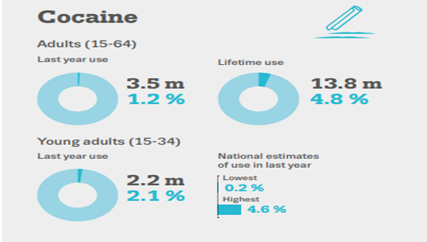
Figure 1 Drug use estimation in the European Union in 2021.22
Generally, Greece seems to have a reduced interest rate of illicit substance usage in comparison with other European nations. In the preceding 25-30 years, the trajectory of cocaine usage between the overall Greek community has been nearly equal to that of the total illicit substance consumption.23 Cocaine is the second most prevalent drug in the region. According to recent research, the declining trend of cocaine use in the European Union, which was reported in previous years, it has been suspended. In research conducted in the country, among 45 cities that collected data from analyzed urban wastewater for cocaine residues in 2018 and 2019, 27 of them reported an increase, 10 a steady state and 8 a decrease. Uptrends are reported for most of the 14 cities that have data for the time period between 2011 to 2019.24
Since the predominance of cocaine abusers do not identify themselves as being addicted, just one small fraction of them consider therapy. Only one small fraction of drug addicts in recovery use cocaine as their prime substance. Nevertheless, it is worth noting that the percentage of individuals requesting help to recover were more than doubled during a two years period.25 Amongst them, 56000 users claimed regular cocaine use, in 2018 while 15000 requested treatments for “crack”.24
In Greece in 2019, there were reported 73 drug-related fatalities. Since there were 253 drug overdoses recorded in 2006, the number of fatal overdoses has declined dramatically throughout the timeframe under examination. Even though it can be challenging to distinguish the way in which the cocaine impacts the user when they are present other variables, for instance the very usual pairing of cocaine and alcohol and/or the health condition of the deceased (Figure 2).26
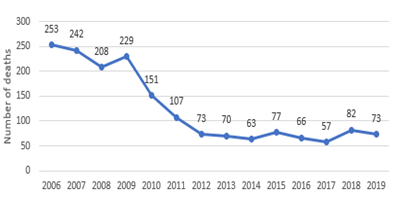
Figure 2 Number of drug overdose deaths in Greece from 2006 to 2019.26
Presumably this is why there has not been an "ethical outrage" over it. During the period of 1993 to 2007, there were 17 cocaine-related fatalities. Nonetheless, there were situations that drew significant public interest, including the loss of a 14-year-old girl from Northern Greece in early 2008. Likewise, the statistics on cocaine overdoses might be ambiguous. The Director of Implementation of Rehabilitation Programs of O.KA.NA contends that because cocaine consumption is more prevalent in the "elite" society, it is undoubtful that fatalities caused by cocaine abuse are recorded as naturally occurred deaths rather than violent for social purposes.27
The increasing availability and use of cocaine "crack" in the region is a cause for concern, and while cocaine prices in European Union have remained stable, the purity of the drug is, in fact, at its highest level in at least a decade.28 More particularly, in 2018, the average cocaine purity at the retail market level across Europe ranged from 23% to 87%, while in Greece the reported average purity was between 53% to 69% in a price range of 54 to 83 euros per gram.24
The appearance rate of uncontrolled chemicals as substitutes for internationally controlled precursors is steadily increasing worldwide, while the variety of chemicals that could be used instead of the controlled precursors is practically unlimited. The inclusion of individual substances through the international control is still delayed in relation to the ingenuity of the traffickers, while many of these substances have no known legal uses and they are not offered for monitoring through legal trade. The International Narcotics Control Board (INCB) urges governments to continue the broader political dialogue, launched in 2019, regarding the potential confrontment of the problem and the implementation of a global framework that would tackle more effectively controlled substances.19
Official statistics and data regarding the cocaine trafficking
Issues related to the illicit production, trafficking and use of substances in South America persist in causing insecurity and violent acts in the region. According to the Global Study for Homicides conducted by UNODC in 2019, firearms are used in homicide incidents in America much more often than in any other part of the world. In Brazil, Colombia, and Venezuela (Bolivian Republic) the homicide rate exceeds the overall average of homicides in the surrounding area.19
Coca cultivation and cocaine production in Colombia have reached the highest level ever. Cocaine production has increased in South America. In Colombia, both illicit coca cultivation and illicit cocaine production increased in 2017 by 17% and 31% respectively.28 The illegal cultivation has grown steadily in its total, from 120,600 hectares in 2013 to an all-time record of 245,000 hectares in 2017. Increased production of hydrochloride cocaine has also been noted in Colombia. Despite the reported decrease in the illegal cultivation of coca bushes in Colombia by 1.2% in 2018, the production capacity of hydrochloride cocaine in the country increased by 5.9%, reaching 1,120 tons. In the Multinational State of Bolivia, the extent of the illegal cultivation of coca bushes decreased in 2018 by 6%. The total area of illegal cultivation of coca bushes in the region could not be estimated in 2019, due to the lack of data on the illegal cultivation of coca bushes in Peru (Figure 3).19

Figure 3 Productive areas under coca bush cultivation and manufacture of cocaine in Colombia, 2005–2019.9
Bolivia adopted a legislation in order to increase coca cultivation. The government of the Bolivian Multinational State passed a legislation in 2017 that allowed the cultivation of up to 22,000 hectares of coca bushes for traditional uses, an area that exceeds the extent that, is necessary to meet the needs in the context of traditional substance use as it was estimated by the Bolivian government in 2013.29 Additionally, the increasing cocaine production in South America appears to have an impact on the European and the North American markets. According to reports about the confiscated amounts, most cocaine is still trafficked through Andean countries, particularly Colombia, to major markets consumption in North America and Europe, where indications of increased availability and use are a cause for concern. Shipments of cocaine seized in South America were destined primarily for the United States.28 During 2009 and 2019, the amount of cocaine seizures grew by 27 percent in Europe, in a slower rate than the amount confiscated. This might imply increase in manufacturing and transportation activity, as well as increased marketplaces in the country.22
In Greece cocaine is confiscated by the Police, the customs, and the coast guard, while the Bureau for Special Inspections seizes a tiny portion of the product. The total amount of cocaine seized in the country by Law Enforcement Authorities in 2019 was 953,422 kg, showing a significant increase (474,8%) compared to 2018 and the estimated "commercial" value of confiscated cocaine exceeded the 81 million euros (Figure 4).30
The percentage of confiscated cocaine found to be coming directly from Latin American totaled at 78.62% (Figure 5).
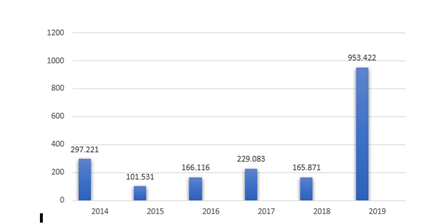
Figure 4 Cocaine confiscations in Kilos, in 2014-2019.30
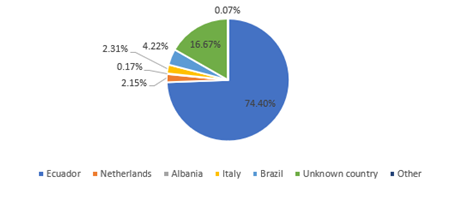
Figure 5 Country of origin of cocaine, in 2019.30
Merchandise resources, the transportation process, and the routes
Greece is not recognized as a cocaine-producing nation. Nevertheless, information received led to a cocaine manufacturing facility in the country. The Bureau for Special Inspections also discovered and demolished a cocaine manufacturing facility in Anavyssos, a municipality in Attica district, where coca powder was processed prior to getting trafficked into Western European marketplaces. The information and subsequent dismantling operation succeeded with the support of the DEA (US Drug Enforcement Administration) and the Greek National Intelligence Service. The purpose of this laboratory, which was labeled by the Greek press as "the first cocaine laboratory in Europe," was to minimize product waste when it was transported because "coca paste" is not difficult to be identified. As it was stated by the police, this facility recruited a chemist from Venezuela and a British immigrant who oversaw the manufacturing and selling process. However, this Greek product, was meant for numerous European marketplaces, and not only for the Greek, which depends heavily on South American products.31
Trafficking patterns into the European Union generally, and in Greece particularly, could be completely understood when a larger context on the overall pathways of the marine commerce and the traveling patterns across Atlantic are obtained. Cocaine is mainly imported into Europe through marine channels, as opposed to heroin, that is typically carried by terrestrial routes. The strategic implementation implies that cocaine trafficking is inextricably linked to marine trade and tourism.32
There are three ways in which cocaine is trafficked
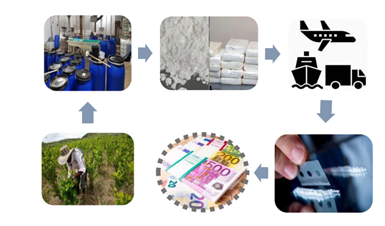
Figure 6 The cocaine route.30
Over the last 20 years, Europe has become a major destination for cocaine produced in South America in two forms: cocaine powder and crack. The most common is cocaine powder (hydrochloride salt), while less common is crack, a form of the substance (free base), which is smoked. The product is transported to Europe by air and by sea.
The means and methods used in the trafficking - import of cocaine in Greece from 2015 were the following
Cocaine shipments appear to pass through the most countries in South and Central America before reaching Europe, but mainly they pass by Argentina, Brazil, Ecuador, Venezuela, and Mexico. The Caribbean islands are becoming important transit point for the transshipment of drugs destined to Europe. The main entry point into the continent, as well as a point for storage and secondary distribution for the European market, is Spain. Spain remains the country with the highest amount of cocaine confiscations in Europe, although there are indications of continued diversification of traffic routes according to seizure reports in Eastern Mediterranean ports, in Baltic and the Black Sea. The reasons that make this country particularly attractive for trafficking, are its large coastline, the close vicinity with Morocco (African Road) and that its borders constitute European Boarders. Following Spain, the Netherlands is the main gateway for cocaine into Europe, because it is an international trade center, but also due to its geographical location and the road network that gives access initially to Europe and consequently to Greece. Additionally, the multicultural society and the "tradition" it has in drug trafficking make it "ideal". In the Netherlands, 1700kg of pure cocaine are consumed annually but it is difficult to calculate the exact magnitude of the quantities imported and exported in that country.
Also, a noteworthy case is the dismantling of a criminal organization, which was active in the transportation and importation of significant drug quantities in Greece, as well as in the storage-falsification, re-standardization, and further distribution in the domestic market, including the infiltration of drugs in Detention Centers. After months of monitoring its activities, its labyrinthine structure was revealed, with the form of liquid criminal networks and its extensive criminal activity. This Group was composed of three (3) subgroups. The first one, was involved in the infiltration of drugs in Detention Centers. The second was responsible for the import-supply from Turkey and Albania, and then forgery-re-standardization and trafficking of the drugs in the greater area of Athens and in other parts of the country, but also in Western Europe. The third was associated with the import-supply from the Netherlands, Turkey, and Albania, then counterfeiting-re-standardization and trafficking of the drugs in the wider region of Attica (Figure 7).
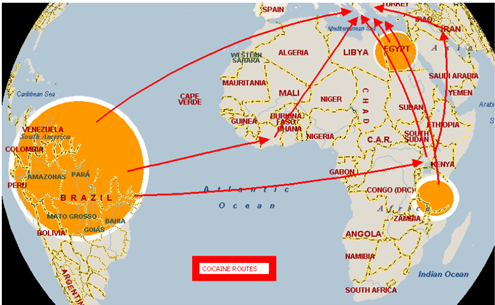
Figure 7 The three main cocaine routes.32
A variety of challenges may arise in the cocaine smuggling sector in Greece. The first one is associated with the 'entities' involved in the sector. In contrary to common perceptions of "organized crime” generally, and the cocaine business above all, no "cartels" are implicated. From the moment the drugs are brought into the country, there are decentralized networks in place, as well as independent people who operate regularly or on opportunistic level, with the primary goal being profit acquisition. Obviously, interpersonal relations hold a significant part in this framework, as they did in the early phases of the Greek cocaine marketplace during the first half of the 20th century.
More precisely, the function of networking opportunities, including the connections amongst professional organizations, is critical in comprehending the formation of the Greek cocaine industry. The assemblance of this networking generates a fragile world of social interactions, quite equivalent to that shown by earlier research, and may be considered as a representation of 'organized crime'. Fundamental components for these organizations are maritime cooperation, entertainment businesses, sport centers, but also interfaces connected to security, police departments, and local elected officials. Even though foreign people can access this network quite easily, there seem to be significant obstacles in entering the commercial sectors that offer camouflage, equipment, and protection. Whenever immigrants integrate into the political and financial society in a more dynamic manner, there is always the possibility to witness a consolidation which alters the existing cocaine trade patterns.
An additional matter which arises regarding the social part of the cocaine trafficking in Greece seems to be the image of the trafficker. There are discrepancies whether how 'elite' individuals and 'stereotypical' criminals appear, and there is frequently a definite distinction between the 'legitimate' and the 'illicit'. Nevertheless, the distinction with the upper and under world, that is strongly established in popular culture and frequently amplified by the mainstream, has been accused of creating a misleading impression of the genuine interaction between the various socioeconomic levels of society.
These have been proposed that perhaps the origin of this misinterpretation emerges mostly from the type of the gathered information and its processing. When different information resources are evaluated, this viewpoint acquires experienced support. Whenever it is explored the delinquents’ understanding of who the 'actual criminal' is as well as what signifies the 'actual crime', it is not unexpected that emphasis switches to white-collar crimes and the organizations and social classes such characters represent. The widespread belief in Greek criminal justice and political offices that the drug consumer is at minimum as dangerous as the supplier fosters a broad safeguarding barrier against the higher echelons of the cocaine business.
Some of the research on 'organized crime' has revealed that the collaboration of police, democratic institutions, officials, and businesses is an irreversible aspect of the preceding years, a foundation, and an evolution of 'organized crime'. It was established from recently developed provable findings that challenge prevailing assumptions, that 'organized crime' is generally defined as a network of collaborative interactions involving government, marketplace, and civil society entities. The cocaine sector procures a stable base for the evaluation of the infiltration and incorporation of 'organized crime' in organizations, which are linked to cultural factors that contribute to cocaine trafficking as well as other illicit activities. It has already been mentioned how important Greek marine enterprises are. Greek shipping companies and organizations linked to the global maritime world have contributed a lot in facilitating the cocaine trafficking beyond the Atlantic by financing and transporting substantial amounts.
Location, geography, commercial and maritime economies, and transnational associations have all played significant roles. The historical processes collided with financial performance indicators, resulting in the establishment of considerable profiting interests and therefore a regulative addiction to trade. Furthermore, the Greek governmental power encourages and cultivates such behavior. Active participation in the cocaine trafficking industry can also be interpreted by systemic aspects, that also indicate that people entangle with drug trafficking driven by financial constraints that inhibit them from making enough money originated from legitimate actions, and in an endeavor to supplement their (legitimate) revenue. This largely, but not entirely, address non-Greek people participating in the transport of limited amounts of cocaine and wholesalers, while from the prospect of the political financial state, 'top' traffickers and legitimate industries operating in the cocaine market are also affected. As was previously stated, the cocaine trade is strongly reliant on Greek maritime, boat possessors, and seamen who are prepared to involve in the enterprise and so form 'key players' within the industry.
The above key players have crossed the threshold of a time period in which they are confronted with harsh, by their values, financial difficulties. The huge decrease in sea fares, combined with the lower worth of the boats, has concluded in a perdition of nearly US$50 billion for 1500 Greek-owned tankers, bunkers, and containers. Shipping piracy also has a fundamental impact since it raises operating expenses and escalates the hazards associated with this sector.34 In such a scenario, more engagement in cocaine smuggling and other illicit markets may be viewed as a way to obtain a competitive edge in the Greek maritime, which is amongst the most significant businesses in the Greek economy.
It is critical to monitor the way in which the cocaine marketplace develops in the midst of a nearly stagnant international economy. The ongoing economic crisis, as well as the overall mindset of self-reliance, opportunism, and immorality, may stimulate the growth and formation of a major European cocaine market. Several concerns necessitate consideration: Are the dynamics of the Greek cocaine industry transforming? How can the maritime industry along with other connected corporate sectors recuperate and counterbalance the massive economic setbacks? What type of enterprise ventures would unethical executives pursue in order to keep their prominent profiles in the corporate world? There are also essential theoretical issues that need to be investigated thoroughly. According to the research of the Greek cocaine marketplace, a well-rounded approach might give the logical method for assessing past and present political and social, financial, and organizational elements which might contribute to the comprehension of 'organized crime'.
The authors report no conflicts of interest.
None.
None.

©2022 O’Hagan, et al. This is an open access article distributed under the terms of the, which permits unrestricted use, distribution, and build upon your work non-commercially.